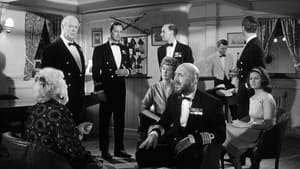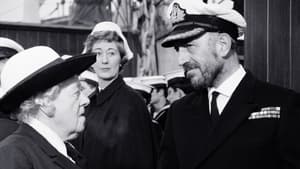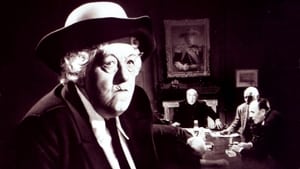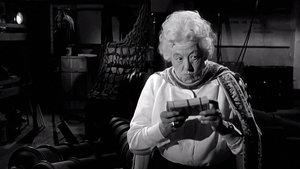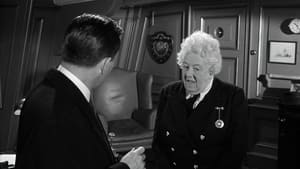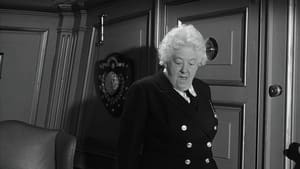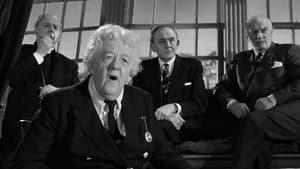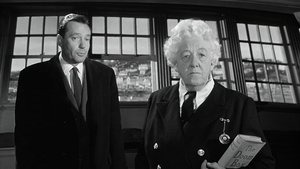Contact: info@alwanfilm.com
Video Sources 0 Views

Synopsis
Review: Murder Ahoy 1964 Colorized – A Classic Whodunit on the High Seas

Introduction
In the pantheon of British comedy-mysteries, Murder Ahoy (1964) holds a special place as one of the most delightful entries in the genre. Directed by George Pollock, the film is a quintessential example of the classic whodunit, blending humor, suspense, and the indomitable presence of Dame Margaret Rutherford. As the fourth and final installment in the Miss Marple film series, Murder Ahoy departs from its predecessors by presenting an original story rather than a direct adaptation of Agatha Christie’s work. In this article, we will explore the film’s charm, its iconic performances, and its place in the annals of cinema.
Check The Full Colorized Movies List
Check Our Colorized Movies Trailer Channel
Understanding Murder Ahoy 1964 Colorized: Director, Cast, and Genre
Murder Ahoy (1964) is a film that perfectly encapsulates the charm and wit of British cinema in the 1960s. Directed by George Pollock, who also helmed the three previous Miss Marple films, the movie showcases his deft touch in blending mystery with light-hearted humor. Pollock’s direction ensures that the film maintains a brisk pace, with plenty of red herrings and clever twists to keep the audience engaged.
At the heart of Murder Ahoy is Dame Margaret Rutherford, whose portrayal of Miss Marple is nothing short of iconic. Rutherford’s Miss Marple is a far cry from the frail, elderly detective often depicted in Christie’s novels; instead, she is a formidable force of nature, brimming with energy, wit, and an unerring sense of justice. The supporting cast includes familiar faces such as Lionel Jeffries, Charles Tingwell, and Stringer Davis, who provide strong performances that complement Rutherford’s inimitable style.
The film falls squarely within the genre of comedy-mystery, a subgenre that blends the suspense of a traditional whodunit with the lightheartedness of a comedy. Murder Ahoy expertly balances these elements, delivering a film that is both entertaining and engaging.
Exploring the World of Murder Ahoy 1964 Colorized: Plot and Characters
The plot of Murder Ahoy revolves around Miss Marple’s investigation into a suspicious death aboard the HMS Battledore, a ship used by a charitable trust to rehabilitate young offenders through naval training. The film begins with Miss Marple becoming a trustee of the charity, but during her first board meeting, one of her fellow trustees, Rear Admiral Sir Geoffrey Buckston, dies suddenly. Although the death is ruled as natural, Miss Marple’s keen instincts suggest foul play, and she sets out to uncover the truth.
Her investigation leads her to the HMS Battledore, where she goes undercover to sniff out the murderer. The ship becomes the setting for a series of mysterious events, each more perplexing than the last. Miss Marple, armed with her sharp wit and insatiable curiosity, navigates the treacherous waters of the ship’s secrets, encountering a colorful cast of characters along the way.
Key characters include Captain Rhumstone (played by Lionel Jeffries), the stern and slightly bumbling captain of the HMS Battledore; Inspector Craddock (Charles Tingwell), who reluctantly assists Miss Marple in her investigation; and the loyal Mr. Stringer (Stringer Davis), Miss Marple’s steadfast companion and confidant. The interactions between these characters, particularly the humorous exchanges between Miss Marple and Captain Rhumstone, provide much of the film’s comedic charm.
The Art of Creating a Whodunit
The whodunit genre, exemplified by Murder Ahoy, is a delicate balance of plot intricacies, red herrings, and character development. The film’s script, penned by David Pursall and Jack Seddon, is a masterclass in constructing a mystery that keeps audiences guessing until the very end. The key to a successful whodunit lies in the careful layering of clues and misdirection, something Murder Ahoy achieves with aplomb.
The film’s setting—a naval training ship—adds an additional layer of intrigue. The confined environment creates a sense of claustrophobia and tension, as every character becomes a suspect and every corner of the ship holds potential secrets. This setting also allows for creative plotting, as the ship’s unique environment is used to stage some of the film’s most memorable scenes, including Miss Marple’s daring antics as she investigates the crew.
The Cinematic Landscape of the 1960s: British Comedy-Mysteries
Murder Ahoy was released during a golden age for British cinema, particularly in the comedy and mystery genres. The 1960s saw a wave of films that combined the quintessentially British sense of humor with elements of suspense and intrigue. These films were often characterized by their witty dialogue, eccentric characters, and intricate plots, all of which are on full display in Murder Ahoy.
George Pollock’s direction, coupled with the film’s sharp script, ensures that Murder Ahoy fits neatly within this tradition. The film’s humor is distinctly British, relying on clever wordplay, situational comedy, and the unique quirks of its characters. At the same time, it maintains the essential elements of a mystery, with a plot that keeps audiences engaged through a series of twists and turns.
Murder Ahoy and Its Place in the Miss Marple Series
Murder Ahoy stands out in the Miss Marple series for several reasons. Unlike the previous films, which were directly based on Agatha Christie’s novels, Murder Ahoy features an original storyline inspired by Christie’s characters. This creative freedom allows the film to explore new territory, both in terms of plot and character development.
Rutherford’s portrayal of Miss Marple in Murder Ahoy is perhaps her most dynamic. She is more physically active, more involved in the action, and her unique brand of humor is given full rein. This version of Miss Marple is not just an observer but an active participant in the investigation, unafraid to take risks and confront danger head-on.
This film also emphasizes the theme of justice, a recurring motif in the Miss Marple series. Miss Marple’s unwavering commitment to uncovering the truth, no matter the personal cost, is a testament to her moral integrity and sense of duty. This theme resonates throughout the film, culminating in a satisfying resolution that sees justice served in classic Miss Marple fashion.
The Debate Over Adaptation vs. Original Storylines
One of the more interesting aspects of Murder Ahoy is its departure from the source material, creating an original storyline rather than adapting one of Agatha Christie’s novels. This decision has sparked debate among fans and critics alike about the merits of staying true to the original material versus exploring new creative avenues.
On one hand, purists might argue that the film should adhere strictly to Christie’s work, preserving the integrity of her storytelling. On the other hand, the decision to craft an original story allows for greater creative freedom, enabling the filmmakers to tailor the plot and characters to suit Rutherford’s unique interpretation of Miss Marple.
In the case of Murder Ahoy, the choice to deviate from the source material works to the film’s advantage. The original storyline is well-crafted and fits seamlessly within the established world of Miss Marple, while also providing fresh content that keeps the series from becoming predictable.
Examining Murder Ahoy 1964 Colorized as a Standalone Film
While Murder Ahoy is part of a larger series, it also stands on its own as an entertaining and engaging film. Even without knowledge of the previous Miss Marple films, viewers can appreciate the film’s humor, mystery, and strong performances. Rutherford’s Miss Marple is an instantly likable character, and the film’s plot is self-contained, ensuring that it can be enjoyed independently of its predecessors.
As a standalone film, Murder Ahoy showcases the strengths of its cast and crew, delivering a polished and enjoyable cinematic experience. The film’s blend of comedy and mystery is well-balanced, making it accessible to a wide audience, from fans of classic whodunits to those who simply enjoy a good laugh.
Influence and Legacy: Murder Ahoy 1964 Colorized’s Impact on Cinema
While Murder Ahoy may not be as widely recognized as some other entries in the mystery genre, its impact on cinema is undeniable. The film’s success helped to solidify the popularity of the Miss Marple character and paved the way for future adaptations of Agatha Christie’s work. It also contributed to the enduring appeal of the comedy-mystery genre, influencing countless films and television shows in the years that followed.
Rutherford’s portrayal of Miss Marple in Murder Ahoy left an indelible mark on the character, shaping the way she would be depicted in subsequent adaptations. Her energetic and humorous take on the role set a precedent that would be difficult for future actresses to follow, and it remains a beloved interpretation of the character to this day.
Director’s Cinematic Legacy: Beyond Murder Ahoy 1964 Colorized
George Pollock, the director of Murder Ahoy, had a significant impact on the British film industry, particularly in the mystery genre. In addition to the Miss Marple series, Pollock directed several other films that demonstrated his skill at balancing suspense and humor. His work on Murder Ahoy and the other Miss Marple films helped to establish a template for successful mystery comedies, blending tight plotting with engaging characters and a light-hearted tone.
Pollock’s influence can be seen in the many mystery films and television series that followed, particularly those that combine elements of comedy with traditional whodunit structures. His ability to create films that are both entertaining and intellectually engaging has left a lasting legacy in the world of cinema.
Themes Explored in Murder Ahoy 1964 Colorized
Murder Ahoy touches on several themes that are central to the Miss Marple series and the mystery genre as a whole. One of the most prominent themes is justice, with Miss Marple’s determination to uncover the truth and see the guilty punished serving as the driving force of the narrative.
The film also explores the theme of duty, particularly through Miss Marple’s unwavering commitment to her role as a trustee and her sense of responsibility toward the young men aboard the HMS Battledore. Her sense of duty extends beyond her official role, encompassing a broader commitment to justice and the well-being of others.
Another key theme is the idea of appearance versus reality, a common motif in mystery stories. Throughout the film, characters and situations are not always what they seem, and Miss Marple’s keen observation skills allow her to see through the deceptions and uncover the truth. This theme is reinforced by the film’s setting, as the seemingly disciplined and orderly environment of the ship hides dark secrets.
Reception and Controversy Surrounding Murder Ahoy 1964 Colorized
Upon its release, Murder Ahoy received a warm reception from both critics and audiences. The film was praised for its humor, engaging plot, and Rutherford’s performance, which many considered the highlight of the film. However, as with any adaptation, there were some who criticized the film for straying from Agatha Christie’s original stories.
Despite these criticisms, Murder Ahoy has endured as a beloved entry in the Miss Marple series and the mystery genre as a whole. The film’s blend of comedy and suspense, along with its memorable characters and clever plot, have ensured its place in the hearts of fans and its continued popularity over the years.
Where to Watch Murder Ahoy 1964 Colorized Online
For those eager to experience the charm and wit of Murder Ahoy, the film is readily available on various streaming platforms. Whether you’re a longtime fan of Miss Marple or a newcomer to the series, Murder Ahoy offers an enjoyable and engaging viewing experience that is sure to delight.
FAQs About Murder Ahoy 1964 Colorized
Q: Is Murder Ahoy based on an Agatha Christie novel?
A: No, Murder Ahoy is not directly based on any of Agatha Christie’s novels. It is an original story inspired by the characters created by Christie, particularly Miss Marple.
Q: How does Murder Ahoy differ from other Miss Marple films?
A: Murder Ahoy differs from other Miss Marple films in that it features an original storyline rather than adapting one of Christie’s novels. It also places a greater emphasis on humor and action, with Miss Marple taking a more active role in the investigation.
Q: What makes Margaret Rutherford’s portrayal of Miss Marple unique?
A: Margaret Rutherford’s portrayal of Miss Marple is unique in that it diverges from the traditional depiction of the character in Christie’s novels. Rutherford’s Miss Marple is more energetic, humorous, and physically active, bringing a distinctive and memorable interpretation to the role.
Conclusion
Murder Ahoy (1964) remains a delightful and engaging entry in the world of British comedy-mysteries, thanks in large part to Margaret Rutherford’s iconic portrayal of Miss Marple. The film’s blend of humor, suspense, and memorable characters ensures its place as a classic of the genre. Whether enjoyed as part of the Miss Marple series or as a standalone film, Murder Ahoy offers a thoroughly entertaining experience that continues to charm audiences to this day. As we revisit this gem of 1960s cinema, it is clear that Murder Ahoy has secured its legacy as a beloved classic, a testament to the enduring appeal of both the whodunit genre and the inimitable Dame Margaret Rutherford.
